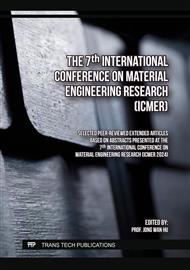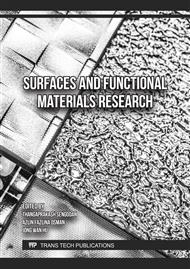[1]
E. Poorakbar, A. Shafiee, A.A. Saboury, B.L. Rad, K. Khoshnevisan, L. Ma'mani, H. Derakhshankhah, M.R. Ganjali, M. Hosseini, Synthesis of magnetic gold mesoporous silica nanoparticles core shell for cellulase enzyme immobilization: improvement of enzymatic activity and thermal stability, Process Biochemistry, 71 (2018) 92-100.
DOI: 10.1016/j.procbio.2018.05.012
Google Scholar
[2]
S. Hong, Y. Choi, Mesoporous silica-based nanoplatforms for the delivery of photodynamic therapy agents, J Pharm Investig, 48 (2017) 3-17.
DOI: 10.1007/s40005-018-00409-9
Google Scholar
[3]
M. Guerritore, R. Castaldo, B. Silvestri, R. Avolio, M. Cocca, M.E. Errico, M. Avella, G. Gentile, V. Ambrogi, Hyper-crosslinked polymer nanocomposites containing mesoporous silica nanoparticles with enhanced adsorption towards polar dyes, Polymers, 12 (2020) 1388.
DOI: 10.3390/polym12061388
Google Scholar
[4]
Y. Chen, X. Zhang, B. Wang, M. Lv, Y. Zhu, J. Gao, Fabrication and characterization of novel shape-stabilized stearic acid composite phase change materials with tannic-acid-templated mesoporous silica nanoparticles for thermal energy storage, RSC Adv, 7 (2017) 15625– 15631.
DOI: 10.1039/c7ra00964j
Google Scholar
[5]
Y. Zhou, W. Song, L. Zhang, S. Tao, Preparation of hollow magnetic porous zirconia fibers as effective catalyst carriers for fenton reaction, J Mater Chem A, 6 (2018) 12298-12307.
DOI: 10.1039/c8ta01286e
Google Scholar
[6]
F. Olivieri, F. Scherillo, R. Castaldo, M. Cocca, A. Squillace, G. Gentile, and M. Lavorgna, Effectiveness of mesoporous silica nanoparticles functionalized with benzoyl chloride in pH-responsive anticorrosion polymer coatings. ACS Appl. Polym. Mater, 5 (2023) 5917-5925.
DOI: 10.1021/acsapm.3c00585
Google Scholar
[7]
Q. Zhu, X. Xu, Y. Huang, S. Liu, A. Zuo, and Y. Tang. pH-responsive mesoporous silica nanocontainers based on Zn-BTA complexes as stoppers for controllable release of corrosion inhibitors and application in epoxy coatings. Prog. Org. Coat, 181 (2023) 107581.
DOI: 10.1016/j.porgcoat.2023.107581
Google Scholar
[8]
R. Castaldo, M. Salzano de Luna, C. Siviello, G. Gentilea, M. Lavorgna, E. Amendola, and M. Cocca, On the acid-responsive release of benzotriazole from engineered mesoporous silica nanoparticles for corrosion protection of metal surfaces, J Cult Herit, 44 (2020) 317-324.
DOI: 10.1016/j.culher.2020.01.016
Google Scholar
[9]
L. Palanikumar, J. Kim, J. Y. Oh, H. Choi, M. H. Park, C. Kim, J. H. Ryu, Hyaluronic acid-modified polymeric gatekeepers on biodegradable mesoporous silica nanoparticles for targeted cancer therapy, ACS Biomater. Sci. Eng, 4 (2018) 1716−1722.
DOI: 10.1021/acsbiomaterials.8b00218
Google Scholar
[10]
D. Borisova, H. Mohwald, D. G. Shchukin, Mesoporous silica nanoparticles for active corrosion particles, ACS Nano, 5 (2011) 1939-1946
DOI: 10.1021/nn102871v
Google Scholar
[11]
Q. Ma, S. V. Nanukuttan, P. M. Basheer, Y. Bai, C. Yang, Chloride transport and the resulting corrosion of steel bars in alkali activated slag concretes, Mater. Struct, 49 (2016) 3663−3677.
DOI: 10.1617/s11527-015-0747-7
Google Scholar
[12]
A. Artesani, F. Di Turo, M. Zucchelli, A. Traviglia, Recent advances in protective coatings for cultural heritage − an overview, Coatings, 10 (2020) 217.
DOI: 10.3390/coatings10030217
Google Scholar
[13]
L. Rumiyanti, S. Garcia, M.M.F. Syamsuri, R. Marjunus, N.I. Istiqomah, C. Chotimah, and E. Suharyadi. Characteristics of Mesoporous Silica Nanoparticles-Benzotriazole (MSN-BTA) Using Rice Husk as an Environmentally Friendly Precursor. Solid State Phenom, 356 (2024) 107-112.
DOI: 10.4028/p-81peok
Google Scholar
[14]
A. Mehta, R. P. Ugwekar, Extraction of silica and other related products from rice husk, Int. j. eng. res. appl, 25 (2015) 43-48
Google Scholar
[15]
L. Rumiyanti, C. Destiana, R. Oktaviani, Syafriadi, R. Marjunus, Chotimah, and E. Suharyadi, Facile pore size control and low-cost synthesis of mesoporous silica nanoparticles based on rice husk, Adv. Nat. Sci. Nanosci. Nanotechnol, 14 (2023) 15007
DOI: 10.1088/2043-6262/acc456
Google Scholar
[16]
Y. Hao, W. Sun, L. Jiang, J. Cui, Y. Zhang, L. Song, Y. Zhang, Self-healing effect of epoxy coating containing mesoporous polyaniline hollow spheres loaded with benzotriazole, Prog. Org. Coat, 159 (2021) 106445
DOI: 10.1016/j.porgcoat.2021.106445
Google Scholar
[17]
F. Olivieri, R. Castaldo, M. Cocca, G. Gentile, M. Lavorgna, Innovative silver-based capping system for mesoporous silica nanocarriers able to exploit a twofold anticorrosive mechanism in composite polymer coatings: tailoring benzotriazole release and capturing chloride ions, ACS Appl. Mater. Interfaces, 13 (2021) 48141–48152.
DOI: 10.1021/acsami.1c15231
Google Scholar
[18]
M. Kim, P. Bhanja, N. Amiralian, C. Urata, A. Hozumi, M.A. Shahriar, Hossain, M. Saad, Alshehri, Y.Bando, T. Ahamad, Y. Yamauchi, Mesostructured silica nanoparticles with organic corrosion inhibitors to enhance the longevity of anticorrosion effect, Chem. Soc. 96(2023) 394-397
DOI: 10.1246/bcsj.20230004
Google Scholar
[19]
B. Qian, M. Michailidis, M. Bilton, T. Hobson, Z. Zheng, D. Shchukin, Tannic complexes coated nanocontainers for controlled release of corrosion inhibitors in self-healing coatings, Electrochim. Acta, 297 (2019) 1035–1041
DOI: 10.1016/j.electacta.2018.12.062
Google Scholar
[20]
C. Guo, J. Cao, Z. Chen, Core-shell mesoporous silica–metal–phenolic network microcapsule for the controlled release of corrosion inhibitor, Appl. Surf. Sci, 605 (2022) 154747
DOI: 10.1016/j.apsusc.2022.154747
Google Scholar
[21]
I.A. Rahman, P. Vejayakumaran, C.S. Sipaut, J. Ismail, C.K. Chee, Synthesis of silica nanoparticles by sol-gel: size-dependent properties, surface modification, and applications in silica-polymer nanocomposites-a review. Mater. Chem. Phys, 114 (2009) 328–332
DOI: 10.1016/j.matchemphys.2008.09.068
Google Scholar
[22]
S. Shamim, L. Gabriel, Hornyak, D. Crespy, H. Kyaw, T. Bora, Morphology and visible photoluminescence modulation in dye-free mesoporous silica nanoparticles using a simple calcination step Mater. Res. Bull, 152 (2022) 111842
DOI: 10.1016/j.materresbull.2022.111842
Google Scholar



